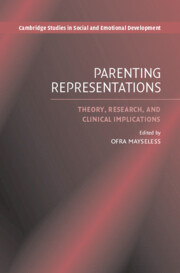Book contents
- Frontmatter
- Contents
- List of Illustrations
- List of Tables
- List of Appendixes
- List of Contributors
- Preface
- Acknowledgments
- Part One Theoretical Perspectives
- 1 Studying Parenting Representations as a Window to Parents' Internal Working Model of Caregiving
- 2 Maternal Representations of Relationships: Assessing Multiple Parenting Dimensions
- 3 Social Cognitive Approaches to Parenting Representations
- Part Two Research Applications
- Part Three Clinical Implications
- Index
- Cambridge Studies in Social and Emotional Development
- References
3 - Social Cognitive Approaches to Parenting Representations
from Part One - Theoretical Perspectives
Published online by Cambridge University Press: 10 July 2009
- Frontmatter
- Contents
- List of Illustrations
- List of Tables
- List of Appendixes
- List of Contributors
- Preface
- Acknowledgments
- Part One Theoretical Perspectives
- 1 Studying Parenting Representations as a Window to Parents' Internal Working Model of Caregiving
- 2 Maternal Representations of Relationships: Assessing Multiple Parenting Dimensions
- 3 Social Cognitive Approaches to Parenting Representations
- Part Two Research Applications
- Part Three Clinical Implications
- Index
- Cambridge Studies in Social and Emotional Development
- References
Summary
Abstract
Social cognitive theorists have studied parenting cognitions that include perspective-taking ability, socialization goals, and attributions made for actions of the self and of the child. These are described, with a focus on their links to parenting actions and child outcomes. The distinction between controlled and automatic cognition and its role in parenting cognitions is discussed, with the former involving movement between the mobilization and minimization of cognitive activity regarding parent–child interactions. It is argued that inappropriate reliance on mobilization or minimization leads to difficulties in information-processing and emotion regulation which result in maladaptive parenting behavior. Finally, similarities and differences between social cognitive and attachment approaches to mental representations of parenting are discussed.
Cognitive constructs have played a prominent role in attempts to understand the impact of parenting on children's social, emotional, and cognitive outcomes. For many years, childrearing attitudes – cognitive events that predispose the individual to act either positively or negatively toward their object – were the dominant focus of researchers and theorists. Indeed, attitudes were assumed to be the preeminent parenting construct (Holden & Buck, 2002) because they were considered to be good predictors of parenting behavior, markers of the emotional climate parents provided to their children, and, therefore, seen to have a major impact on children's development. Psychoanalysts (e.g., Horney, 1933) argued that parenting behavior was determined by unconscious emotional reactions parents had to the way they themselves had been parented, with these unconscious reactions having an effect on their own, conscious, attitudes.
- Type
- Chapter
- Information
- Parenting RepresentationsTheory, Research, and Clinical Implications, pp. 79 - 106Publisher: Cambridge University PressPrint publication year: 2006
References
- 10
- Cited by



